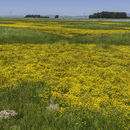Comments
provided by eFloras
Epappose plants of Lasthenia fremontii are rarely found and then only in the southernmost part of its range in Tulare and San Luis Obispo counties, where they occur together with pappose plants. The ranges of L. fremontii and L. conjugens overlap slightly; the two species have not been found growing together.
- license
- cc-by-nc-sa-3.0
- copyright
- Missouri Botanical Garden, 4344 Shaw Boulevard, St. Louis, MO, 63110 USA
Description
provided by eFloras
Annuals, to 35 cm. Stems erect, branched proximally, glabrous proximally, ± hairy distally. Leaves linear, 10–60 × 1–2+ mm (simple blades or single lobes), margins entire or with 1–3 pairs of linear lobes, faces glabrous or sparsely hairy. Involucres hemispheric or obconic, 4–6 mm. Phyllaries 8–16 (distinct), ovate, hairy. Receptacles dome-shaped, muricate, hairy. Ray florets 6–13; laminae oblong to oval, 5–7 mm. Anther appendages linear to narrowly ovate. Cypselae black or gray, clavate, to 1.5 mm, usually scabrous, rarely glabrous; pappi usually of (3–)4(–5) subulate, aristate scales plus 3–5+ shorter, ± subulate scales or teeth, rarely of aristate scales only, or 0. 2n = 12.
- license
- cc-by-nc-sa-3.0
- copyright
- Missouri Botanical Garden, 4344 Shaw Boulevard, St. Louis, MO, 63110 USA
Synonym
provided by eFloras
Dichaeta fremontii Torrey ex A. Gray, Mem. Amer. Acad. Arts, n. s. 4: 102. 1849; Baeria fremontii (Torrey ex A. Gray) A. Gray
- license
- cc-by-nc-sa-3.0
- copyright
- Missouri Botanical Garden, 4344 Shaw Boulevard, St. Louis, MO, 63110 USA
Brief Summary
provided by EOL authors
Lasthenia fremontii is a California endemic restricted to the California Central Vallley. It occurs in vernal pools.
This annual wildflower attains a maximum height of 35 centimeters. Stems are erect, simple or branched from base, and more or less hairy The linear, entire leaves are one to six centimeters long and have one to three pairs of linear lobes.
With a common name of Fremont's goldfields, this wildflower is named to honor John Charles Fremont, a Republican presidential candidate, who was the first presidential candidate to oppose slavery.
Comprehensive Description
provided by North American Flora
Baeria fremontii (Torr.) A. Gray, Proc. Am. Acad. 9: 196
1874.
Dichaela Fremontii Torr.; A. Gray, Mem. Am. Acad. II. 4: 102. 1849.
Burrielia Fremontii Benth. PI. Hartw. 317. 1849.
Baeria Burkei Greene, Bull. Calif. Acad. 2: 151. 1886.
Lasthenia conjugens Greene, Pittonia 1: 221. 1888.
Lasthenia Fremontii Greene, Man. Bay Reg. 204. 1894.
Lasthenia Burkei Greene, Man. Bay Reg. 204. 1894.
Annual, very slender, or sometimes slightly succulent, simple to freely branched, erect, 0.8-3 dm. high, nearly glabrous below, densely and finely pubescent on peduncles and involucres; leaves mostly parted into linear lobes but some of the upper nearly filiform and entire, rarely all entire in slender plants ; peduncles much exceeding the upper leaves ; involucre hemispheric, 4-6 mm. high; bracts 10-12, broadly ovate, acute, overlapping, usually distinct but occasionally united near the base {Lasthenia conjugens) , not keeled, strigose-pubescent at least near the margins, inclined to be deciduous with their achenes at maturity; receptacle subglobose or dome-shaped, low-muricate, densely hirsute; ray-flowers about 10-12, the ligules elliptic and 3-6 mm. long; disk-corollas 2.5-3 mm. long, the tube hirsutulous and glandular; achenes scarcely more than 1 mm. long, prismatic or slightly compressed, black, upwardly scabrous; pappus of 1-4 slender awns and 4 or more short quadrate lacerate squamellae, or the pappus wanting and the achenes then smooth and shining.
Type locality: California.
Distribution: Middle California, especially in the Sacramento Valley.
- bibliographic citation
- Per Axel Rydberg. 1914. (CARDUALES); CARDUACEAE; HELENIEAE. North American flora. vol 34(1). New York Botanical Garden, New York, NY
Lasthenia fremontii: Brief Summary
provided by wikipedia EN
Lasthenia fremontii is a species of flowering plant in the family Asteraceae known by the common name Frémont's goldfields (after John C. Frémont). It is endemic to the California Central Valley, where it grows in vernal pools and meadows.
- license
- cc-by-sa-3.0
- copyright
- Wikipedia authors and editors

